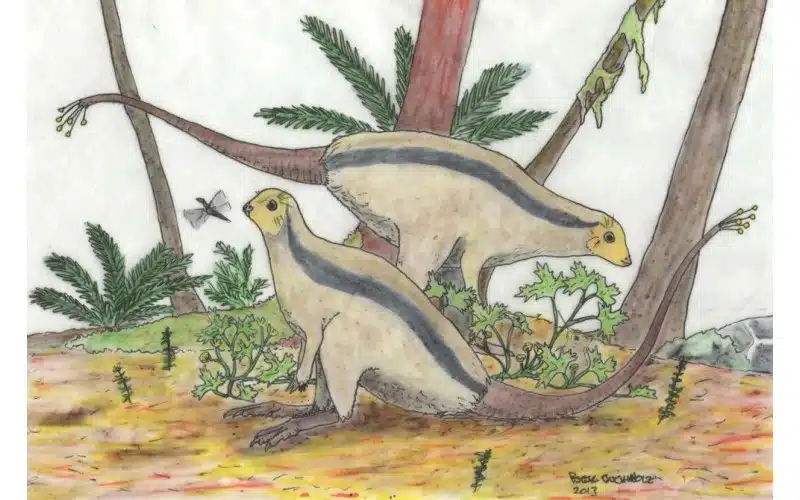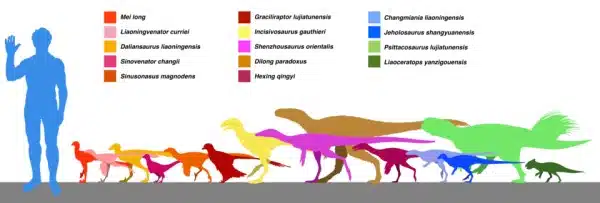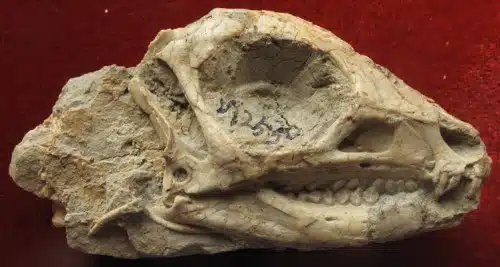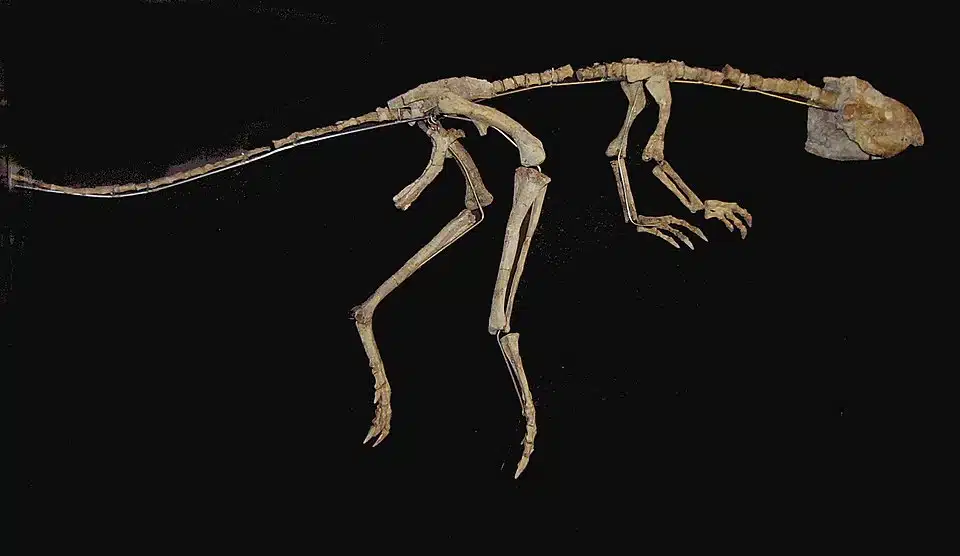In the volcanic landscapes of Early Cretaceous China, a nimble, bipedal herbivore darted between ferns and conifers, leaving only faint traces behind in the fossil record. Known as Jeholosaurus, this dinosaur lived over 120 million years ago, navigating a world teeming with feathered predators and armored neighbors. Though modest in stature, Jeholosaurus represents an important piece in the evolutionary puzzle of neornithischians—the primary branch of Ornithischia, a major clade of herbivorous dinosaurs that includes the armored, plated, horned, and duck-billed forms.
The fossils of this agile dino were first uncovered in the Lujiatun beds, the lowest part of the Yixian Formation in Liaoning Province—a site renowned for its exceptional fossil preservation. Despite its modest proportions, Jeholosaurus has become an important reference point for understanding ornithischian evolution in East Asia, thanks to its mix of primitive and derived traits that help clarify the early diversification of the group.
Jeholosaurus Key Facts
| Keyword | Fact |
|---|---|
| Pronunciation | JAY-hoh-loh-SAW-rus |
| Meaning of name | Jehol lizard |
| Group | Neornithischia |
| Type Species | Jeholosaurus shangyuanensis |
| Diet | Herbivore |
| When it Lived | 126 – 124 MYA |
| Period | Early Cretaceous |
| Epoch | Barremian |
| Length | ~2.6 feet |
| Height | ~1.3 foot |
| Weight | ~6.6 pounds |
| Mobility | Moved on two legs |
| First Discovery | 2000 by unknown discoverer |
| Described by | 2000 by Xu Xing, Wang Xiao-Lin, and You Hai-Lu |
| Holotype | IVPP V 12529 |
| Location of first find | Lujiatun, Beipiao City, Liaoning Province, China |
Jeholosaurus Origins, Taxonomy and Timeline
The name Jeholosaurus comes from “Jehol,” an old transliteration of a region covering modern Liaoning and Hebei provinces in China. This area’s fossil beds are among the richest in the world. The suffix “-saurus,” derived from Greek, means “lizard,” making the full name translate simply to “Jehol lizard.”

Determining the precise phylogenetic relationships of Jeholosaurus shangyuanensis has proven challenging. Over the years, different analyses have placed it either within basal Ornithopoda or in a more primitive position among early neornithischians, outside of Ornithopoda proper. This variability reflects its mosaic of anatomical features, which combine primitive neornithischian traits with some characteristics seen in early ornithopods. Regardless of its exact placement, Jeholosaurus remains a key taxon for understanding ornithischian diversity and the early evolutionary history of ornithopods.
This little herbivore lived during the Early Cretaceous Period, specifically during the Barremian epoch, roughly between 124 and 126 million years ago. It thrived in the Lujiatun ecosystem—an environment preserved under rapid volcanic ashfalls, which helped fossilize animals in lifelike poses with minimal distortion, offering paleontologists exceptionally well-preserved, three-dimensionally articulated skeletons.
Discovery & Fossil Evidence
The original Jeholosaurus specimens were unearthed in 2000 in the Lujiatun Beds of western Liaoning Province, a part of the world-renowned Yixian Formation. The holotype is preserved in nearly complete, three-dimensional form, offering an unusually clear look at this small ornithischian’s skeleton.
The original Jeholosaurus specimens were unearthed in 2000 in the Lujiatun Beds of western Liaoning Province, part of the world-renowned Yixian Formation. The holotype consists of a partial skeleton—including a skull with attached mandibles, articulated cervical and caudal vertebrae, a fragmentary sacrum, and both hindlimbs—preserved in three dimensions. While incomplete, it provides valuable anatomical detail that has helped clarify aspects of this small ornithischian’s morphology.
Since that initial discovery, several additional specimens have been referred to the genus, including partial skulls and postcranial material from both juveniles and subadults. These have expanded our understanding of its anatomy and allowed researchers to examine growth patterns and ontogeny. Many of these fossils are exceptionally well-preserved and show minimal deformation—an uncommon trait for animals of this size and fragility.
All known specimens come from the same locality, suggesting that Jeholosaurus may have had a relatively limited geographic range or a strong preference for the specific conditions of the Lujiatun ecosystem. While skeletal material is well represented, there is currently no direct fossil evidence of skin or feather-like coverings.
- Jeholosaurus skeleton
- Jeholosaurus shangyuanensis (IVPP V12530).
- Skeleton of Jeholosaurus sp. on display at the Tianjin Natural History Museum.
Jeholosaurus Size and Description
Although small by dinosaur standards, this dinosaur packed remarkable evolutionary features into its light frame. Its build suggests a lifestyle of speed, agility, and constant foraging in a dynamic environment.
Short description of Jeholosaurus
The body of Jeholosaurus was compact and lightweight. It had a long tail that likely served as a counterbalance during movement, a narrow head with large eye sockets, and a beak-like snout suited for cropping vegetation. Its forelimbs were relatively short compared to the hind limbs, and each foot ended in clawed digits—likely used for general functions such as grasping or stability, rather than for predation.
Its posture and limb proportions suggest a primarily bipedal stance, with adaptations that may have allowed for quick movement—potentially useful for avoiding predators. Although no direct skin impressions have been found, it is plausible that Jeholosaurus bore scales or even filament-like protofeathers, as seen in some related or coexisting species.
Size and Weight of Type Species
Jeholosaurus shangyuanensis is estimated to have reached about 2.6 feet (0.8 meters) in length and stood roughly 1.3 feet (0.4 meters) tall at the hip. Based on body proportions, it likely weighed around 6.6 pounds (3 kilograms), comparable in size to a modern chicken or pheasant. However, all known specimens represent subadult individuals, so the full adult size remains uncertain.

Its small stature would have made it vulnerable to predators, but also may have enabled it to take refuge in underbrush or use quick bursts of speed to escape danger. Some researchers have speculated that it could have been crepuscular or nocturnal, though there is currently no direct evidence to confirm its daily activity pattern.
These dimensions place Jeholosaurus among the smaller known neornithischians, yet its anatomy already shows signs of specialization—reflecting a broader evolutionary shift toward faster, more agile herbivores.
The Dinosaur in Detail
Jeholosaurus shows a combination of anatomical features that place it near the base of the ornithopod lineage, while still retaining several more primitive traits typical of early neornithischians. These include a relatively simple jaw structure paired with more derived hindlimb proportions suited for efficient bipedal locomotion.
Its teeth were small and numerous, likely adapted for cropping and processing soft vegetation. Unlike more derived ornithopods, it lacked complex dental batteries, but its dentition and jaw structure—including a ridge that may have helped stabilize the bite—suggest it was well-suited to a herbivorous diet.
The large orbits in its skull point to well-developed vision. This, combined with its agility, may have helped it detect and evade predators. While there is no direct evidence of social behavior, it is possible that Jeholosaurus engaged in basic group dynamics, similar to those inferred in other small ornithischians, possibly for foraging or protection.
Interesting Points about Jeholosaurus
- Among the smallest known ornithischian dinosaurs, Jeholosaurus was comparable in size to a modern chicken—compact, lightweight, and built for agility.
- Its name honors the historical term “Jehol,” once used for the region now known as western Liaoning and northern Hebei, where its fossils were first unearthed.
- Unlike many flattened specimens from the same formation, its fossils are preserved in remarkable three-dimensional condition, offering rare anatomical clarity.
- This little herbivore shared its ecosystem with feathered theropods and some of the earliest birds, making it a contemporary of some of the most pivotal evolutionary transitions in dinosaur history.
- Its skeletal structure reflects a mosaic of traits—some shared with more primitive neornithischians, others resembling those of later ornithopods. Whether these similarities represent true ancestry or convergent evolution remains uncertain, but they highlight Jeholosaurus as a key taxon for understanding early ornithischian diversification.
Contemporary Dinosaurs
Among the larger herbivores inhabiting the same Cretaceous forests was Psittacosaurus, a small but robust ceratopsian. Kown for its parrot-like beak and powerful jaws. Larger and more heavily built than Jeholosaurus, it likely fed on a range of vegetation, potentially browsing at different heights or on tougher plant material, which may have allowed the smaller dinosaur to focus on low-lying plants and ground cover. This vertical partitioning of their diets would have minimized competition and allowed multiple herbivores to coexist in the same ecosystem.
Wandering through the same lush terrain was Beipiaosaurus, a feathered therizinosaur notable for its long arms and curved claws. Unlike most theropods, it leaned toward an herbivorous or omnivorous lifestyle, browsing for soft plants or small animals. While its foraging patterns probably didn’t overlap much with Jeholosaurus, their co-presence in the ecosystem added to a rich mosaic of ecological roles and feeding strategies.
Patrolling the forest was Yutyrannus, a large feathered tyrannosauroid and one of the biggest known feathered dinosaurs. As an apex predator, Yutyrannus would have posed a significant threat to many smaller dinosaurs, including Jeholosaurus. Its presence hints at the dynamic predator-prey interactions shaping the ecosystem.
Gliding through the skies above was Confuciusornis, an early bird with a toothless beak and distinctive long tail feathers. Though not a direct threat to Jeholosaurus, its presence highlights the rich diversity of the ecosystem. With early avian species beginning to carve out their own niches alongside non-avian dinosaurs.
Jeholosaurus in its Natural Habitat
The world that Jeholosaurus inhabited was shaped by active volcanism and was rich in prehistoric vegetation. This environment experienced a temperate, seasonal climate, with alternating wet and dry periods. Thick forests dominated by conifers, cycads, and ferns blanketed the landscape, interspersed with open glades and freshwater lakes, creating a diverse mosaic of habitats.
Feeding mostly on soft foliage, this small herbivore likely browsed on ferns, tender shoots, and low-growing plants along forest edges. It may have traveled in loose groups, which would have offered protection while foraging in the dense undergrowth. Its slender frame and agility made it well-suited for quick bursts of speed, allowing it to dart into thickets when threatened.
Keen senses—especially sight and hearing—would have been vital for detecting predators in the complex, multi-layered terrain. While direct evidence of its social behavior is lacking, moving in small groups would have increased its chances of survival. As both a browser and prey species, Jeholosaurus played an important role in its ecosystem. Contributing to plant regulation and sustaining the food web.
Frequently Asked Questions
It was a small bipedal herbivore, part of the group Neornithischia.
It grew to about 2.5 feet in length and weighed around 6.5 pounds.
It was found in the Lujiatun Beds in Liaoning Province, China.
It ate plants—mostly low-growing ferns, leaves, and possibly soft fruits.
Its primary defense was likely to stay hidden in dense underbrush. Its fallback being using speed and agility to quickly dart away if threatened.
Though not confirmed, it likely moved in small herds for safety and social behavior.
Sources
The information in this article is based on various sources, drawing on scientific research, fossil evidence, and expert analysis. The aim is to provide a comprehensive and accurate overview of Jeholosaurus. However, please be aware that our understanding of dinosaurs and their world is constantly evolving as new discoveries are made.
- https://www.researchgate.net/publication/292405575_A_primitive_ornithopod_from_the_Early_Cretaceous_Yixian_Formation_of_Liaoning
- https://www.sciencedirect.com/science/article/abs/pii/S0031018217304832
- https://www.researchgate.net/publication/260140027_Postcranial_Anatomy_of_Jeholosaurus_shangyuanensis_Dinosauria_Ornithischia_from_the_Lower_Cretaceous_Yixian_Formation_of_China
Article last fact checked: Joey Arboleda,12-05-2025
Featured Image Credit: Dinopedia




